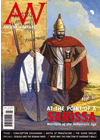|
|

This issue of Ancient Warfare focuses on the soldiers of the Hellenistic era, a period best know for the massive multinational armies that fought for control of Alexander the Great's empire, but that also saw a number of smaller states maintain their own forces. Just about all of these powers ended up being swallowed by either Rome or Parthia, but only after dominating the Aegean and Middle East for several centuries.
The articles on the theme are split between those that look at the soldiers (Macedonian conscripts, Jewish warriors, the Silver Shields) and those that look at their armies (Achaean League, hypaspist corps) and battles.
As always there is an interesting mix of articles, in this case often casting a different light on the Hellenistic world. The article on Philip V of Macedonia's conscription decree gives us a picture of a well thought out plan that was designed not to put too much strain on individual families. The article on the rather confusing hypaspist corps of Alexander's army produces a coherent structure from Arrian's rather varied references to it (convincing, but based on the assumption that Arrian knew what he was talking about, and wasn't simply confusing earlier mixed up references himself).
One article looks at the Silver Shields, an elite formation under Alexander the Great that continued to fight until most of its members were in their sixties. There is a tendency to question just how these older soldiers managed to operate on the battlefield, but I now have something of an insight into this, as a volunteer with an outdoors conservation project. Many of our members fall into the same age group, and amongst them are a core of people (most of whom volunteer several times a week) with more stamina or strength than any of the younger members of the group. I see no reason why this couldn't have been the same in antiquity. There were originally 3,000 Silver Shields and there is no mention of them recruiting replacements to make up for losses, but there must have been a hardcore of surviving members of the original unit who were still perfectly capable of keeping up with most of their younger colleagues, even as the unit shrank in size.
Away from the main theme we have an article on Hadrian's Wall that reminds use how little we really know about it – we can't even be sure what the top of the wall looked like, and a rather evocative look at the threat of disease in the Roman Army, a threat that took more soldiers than warfare.
Articles - Theme
At the point of a sarissa - Historical introduction
Boys and old men - The Conscription Diagramma
The hypaspist corps - Three units, many functions
Citizen soldiers - Rise and fall of the Achaean League
Warriors of Zion - Jewish soldiers in Hellenistic armies
The reenactor - A Late Hellenistic Macedonian officer
The Battle of Paraetacene - The fight for Alexander's Asia
Old men's war - The Silver Shields after Alexander
To the strongest - Defection and the Hellenistic soldier
Articles - Other
Fighting the hidden enemy - Disease and the Roman Army
The function of Hadrian's Warr - Military defence or customs barrier?
Hollywood Romans - The Silver Chalice
Go to Ancient Warfare Magazine Website